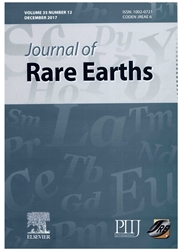

 中文摘要:
中文摘要:
A complete solid solutions with monophasic zircon-type structure of vanadates of formula GdxBi0.95-xVO4:0.05Eu3+(x = 0–0.95) are synthesized by combined method of co-precipitation and hydrothermal synthesis. Their microstructures and morphologies are characterized by X-ray powder diffraction and transmission electronic microscope, and the results show that each of all the samples has a monophasic zircon-type structure. The absorption spectrum of the prepared phosphor shows a blue-shift of the fundamental absorption band edge with increasing the gadolinium content. Under UV-light and visible-light excitation, all the prepared phosphors show the typical luminescence properties of Eu3+in the zircon-type structure. The emission intensity of GdxBi0.95-xVO4:0.05Eu3+(x = 0.55) is strongest in all samples under UV-light and visible-light excitations. Finally, the mechanisms of luminescence of Eu3+in the GdxBi0.95-xVO4:0.05Eu3+(x = 0–0.95)solid solutions are analyzed and discussed.
 英文摘要:
英文摘要:
A complete solid solutions with monophasic zircon-type structure of vanadates of formula GdxBio.95-xVO4:0.05Eu3+ (x = 04).95) are synthesized by combined method of co-precipitation and hydrothermal synthesis. Their microstructures and morphologies are characterized by X-ray powder diffraction and transmission electronic microscope, and the results show that each of all the samples has a monophasic zircon-type structure. The absorption spectrum of the prepared phosphor shows a blue-shift of the fundamental absorption band edge with increasing the gadolinium content. Under UV-light and visible-light excitation, all the prepared phosphors show the typical luminescence properties of Eu3+ in the zircon-type structure. The emission intensity of GdxBi0.95-xVO4:0.05Eu3+ (x = 0.55) is strongest in all samples under UV-light and visible-light excitations. Finally, the mechanisms of luminescence of Eu3+ in the GdxBi0.95-xVO4:0.05Eu3+ (x = 0-0.95) solid solutions are analyzed and discussed.
 同期刊论文项目
同期刊论文项目
 同项目期刊论文
同项目期刊论文
 期刊信息
期刊信息
